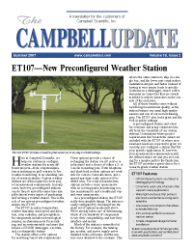Wind power is the world's fastest growing energy source. In the past five years, wind-power capacity in the United States has grown dramatically, now exceeding 11,603 megawatts. Technological improvements to wind turbines, favorable economics, and public demand continue to drive this remarkable growth. Measurements definitely matter in this industry as multimillion-dollar decisions must be based on reliable data. Because of the need for quality measurements, Campbell Scientific products are ideally positioned to impact all three phases of wind-farm development: prospecting for wind, monitoring wind turbine performance, and wind forecasting.
Wind Prospecting
The word prospecting is often associated with the 1849 California gold rush, when miners would stake claims using a best-guess method then start looking for gold. In 2007, wind is gold if you can find a location with wind speeds over 12 mph average.
How do you prospect for wind? Wind consultants use Campbell Scientific measurement products to evaluate potential sites. To accomplish this, several 164- to 260-foot towers are erected and wind speed and direction sensors are installed at three or four different heights. A datalogger and telemetry equipment are installed at the base of the tower. Based on the data from an assessment period of at least one year, a decision can be made about the suitability of the site for wind power and the best wind turbine to use. The rugged, low-power design of Campbell Scientific equipment, combined with multiple telemetry and sensor options, makes it ideal for the long-term, stand-alone monitoring required by this application.
Turbine Performance
Once wind turbines are installed, our systems can monitor power generated by the turbines to help verify manufacturer specifications. This is accomplished by comparing data from the assessment tower to the electricity generated by the turbines. Often, the same dataloggers used for prospecting can be used for turbine performance. Data is critical here because undergenerating by even a few percentage points will make the difference between black and red on the corporate balance sheet. This data can also be used to detect potential problems with turbines.
Wind Forecasting
To sell wind power once a wind farm has been established, operators need to accurately predict how much power their turbines will produce. The ability to predict power generation requires advanced, location-specific models. Weather stations placed strategically across a wind farm provide local meteorological data. This data is combined with regional weather patterns to predict wind 12 to 72 hours in advance.
Measurements matter in the windpower industry. Visit our Web site at www.campbellsci.com/wind to learn about our products, read case studies, configure a system, or request a quote.
Elements of Wind Energy
Typical Measurements
- Wind speed (multiple heights)
- Wind direction (multiple heights)
- Barometric pressure
- Temperature
- Current
- Voltage
- Power
Recommended Products
- CR1000 Measurement and Control System
- Met One, RM Young, or NRG wind speed and direction sensors
- LLAC4 4-Channel Low-Level AC Conversion Module

